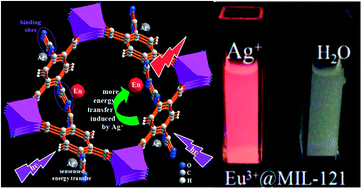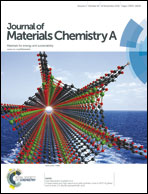Highly sensitive and selective fluorescent probe for Ag+ based on a Eu3+ post-functionalized metal–organic framework in aqueous media†
Abstract
A 3D microporous compound Al(OH) (H2btec)·H2O (MIL-121) containing uncoordinated carbonyl groups is selected as a parent metal–organic framework (MOF). Moreover, because the uncoordinated carbonyl groups in the channels could act as a postsynthetic modification sites, a robust luminescent lanthanide-based MOF can be constructed by encapsulating Eu3+ cations into the pores of MIL-121. The intense luminescence of Eu3+ incorporated MIL-121 products demonstrates that the framework with rigid, permanently porous structure and non-coordinated carboxyl group is an efficient scaffold for hosting and sensitizing Eu3+ cations. More significantly, the robust Eu3+@MIL-121 shows excellent selectivity, fast detection time (<5 min), and high sensitivity (detection limit, 0.1 μM) for Ag+ ions in aqueous solution due to a great enhancement of the Eu3+-luminescence. This is a rare example of Ag+ detection in aqueous solutions based on a luminescent lanthanide MOFs.


 Please wait while we load your content...
Please wait while we load your content...